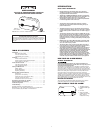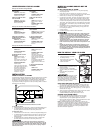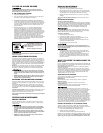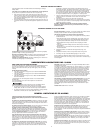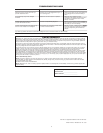
INSTALLATION
WHERE TO INSTALL CO ALARMS
The National Fire Protection Association (NFPA) recommends that a CO Alarm
should be centrally located outside of each separate sleeping area in the
immediate vicinity of the bedrooms. For added protection, install additional
CO Alarms in each separate bedroom, and on every level of your home.
If your bedroom hallway is longer than 40 feet (12 meters), install a CO Alarm
at BOTH ends of the hallway.
In a Single-level Home:
• Install at least one CO Alarm near or within each separate sleeping area.
• For added protection, install an additional CO Alarm at least 20 feet
(6 meters) away from the furnace or fuel burning heat source.
In a Multi-level Home:
• Install at least one CO Alarm near or within each separate sleeping area.
• For added protection, install at least one CO Alarm on each level of the
home. If you have a basement, install that CO Alarm at the top of the
basement stairs.
• For added protection, install an additional CO Alarm at least 20 feet
(6 meters) away from the furnace or fuel burning heat source.
This unit should receive continuous electrical power. (The battery is
meant for emergency back-up only). Choose an outlet where it can’t be
accidentally unplugged or switched off by children. Keep small children
away from the unit. Teach them not to play with it or unplug it. Explain
what the alarms mean.
2
UNDERSTANDING YOUR CO ALARM
What you see and hear during installation
GARAGE
SUGGESTED AREAS FOR INSTALLING ADDITIONAL CO ALARMS
BEDROOM
BEDROOM
HALL
LIVING ROOM
KITCHEN
BASEMENT
BEDROOM
REQUIRED TO MEET NFPA RECOMMENDATIONS
WHEN YOU FIRST INSTALL
THE BATTERY:
HORN:
May chirp briefly
POWER/ALARM LIGHT:
Flashes once a minute
WHEN YOU FIRST PLUG-IN
THE CO ALARM:
HORN:
May chirp briefly
POWER/ALARM LIGHT:
Shines continuously
UNDER NORMAL CONDITIONS
(AC POWER):
HORN:
Silent
POWER/ALARM LIGHT:
Shines continuously
WHEN YOU TEST THE CO
ALARM:
HORN:
Sounds loudly - 4
beeps, pause, 4 beeps,
pause
POWER/ALARM LIGHT:
Flashes rapidly
What you see and hear under different conditions:
DURING A POWER FAILURE
(IN BATTERY BACK-UP):
HORN:
Silent
POWER/ALARM LIGHT:
Flashes once a minute.
WHEN THE ELECTRICITY
COMES BACK ON AFTER A
POWER FAILURE:
HORN:
May chirp briefly
POWER/ALARM LIGHT:
Shines continuously.
IF BATTERY BECOMES LOW
OR IS MISSING:
HORN:
Chirps once a minute
POWER/ALARM LIGHT:
Flashes once a minute
IF THE CO ALARM IS NOT
OPERATING PROPERLY:
HORN:
Three rapid chirps
every minute
POWER/ALARM LIGHT:
Flashes three times with
the horn.
What you see and hear if CO is detected:
PRE-ALARM LEVELS:
HORN:
Silent
POWER/ALARM LIGHT:
On continuously
ALARM LEVELS OF CO ARE
DETECTED:
HORN:
Sounds loudly - 4
beeps, pause, 4 beeps,
pause.
This sequence repeats for as
long as the unit is in alarm*
POWER/ALARM LIGHT:
Flashes rapidly
*Note: If unit goes into alarm
under battery back-up power,
the regular 4 beeps-brief
pause cycle will repeat for
four minutes. After four
minutes, the pause will
increase to 1 minute.
IF YOU SILENCE THE ALARM:
HORN:
Silent for about
4 minutes
POWER/ALARM LIGHT:
Flashes rapidly
Note: After 4 minutes, if
CO levels drop below alarm
levels, the unit will remain
silent and return to normal
operation.
If CO presence still indicates
a potentially dangerous
situation, the horn will sound
again.
IF THE CO LEVELS RETURN
TO NORMAL:
HORN:
Silent
POWER/ALARM LIGHT:
Shines continuously
WHERE CO ALARMS SHOULD NOT BE
INSTALLED
DO NOT LOCATE THIS CO ALARM:
• In garages, kitchens, furnace rooms, or in any extremely dusty,
dirty or greasy areas.
• Closer than 15 feet (4.6 meters) from a furnace or other fuel
burning heat source, or fuel burning appliances like a water heater.
• Within 5 feet (1.5 meters) of any cooking appliance.
• In extremely humid areas. This Alarm should be at least 10 feet (3
meters) from a bath or shower, sauna, humidifier, vaporizer, dish-
washer, laundry room, utility room or other source of high humidity.
• In areas where temperature is colder than 40˚F (4˚C) or hotter than
100˚F (38˚C). These areas include non-airconditioned crawl spaces,
unfinished attics, uninsulated or poorly insulated ceilings, porches,
and garages.
• In turbulent air, like near ceiling fans, heat vents, air conditioners,
fresh air returns, or open windows. Blowing air may prevent CO
from reaching the sensors.
• In direct sunlight.
• In outlets covered by curtains or other obstruction.
• This CO Alarm is designed for use inside a single-family home
or apartment. It is not meant to be used in common lobbies,
hallways, or basements of multi-family buildings unless working
CO Alarms are also installed in each family living unit. CO
Alarms in common areas may not be heard from inside individ-
ual family living units.
• This CO Alarm alone is not a suitable substitute for complete
detection systems in places which house many people, like
hotels or dormitories, unless a CO Alarm is also placed in each
unit.
• DO NOT use this CO Alarm in warehouses, industrial or com-
mercial buildings, special-purpose non-residential buildings,
RVs, boats, or airplanes. This CO Alarm is specifically designed
for residential use, and may not provide adequate protection in
non-residential applications.
HOW TO INSTALL YOUR CO ALARM
PLUG THE ALARM INTO AN OUTLET
1. Plug the unit into a standard UNSWITCHED 120V AC outlet. The
unit should be located where it can wake you if it alarms at night.
2. Make sure the POWER/ALARM light shines continuously when you
plug it in. The horn may “chirp” during power up, or when power is
restored after an outage.
3. Test by pressing the Test/Silence button firmly until the unit sounds:
four loud beeps, pause, 4 beeps. During testing, the
POWER/ALARM light will flash rapidly. This is normal.
PREPARE YOUR ALARM LABELS
Find the pair of self-adhesive labels included with this CO Alarm.
• On each label write in the phone number of your emergency
responder (like 911) and a qualified appliance technician.
• Place one label near the CO Alarm, and the other label in the “fresh
air” location you plan to go if the alarm sounds.
NOTE: A qualified appliance technician is defined as “a person, firm,
corporation, or company that either in person or through a representative,
is engaged in and responsible for the installation, testing, servicing, or
replacement of heating, ventilation, air conditioning (HVAC) equipment,
combustion appliances and equipment, and/or gas fireplaces or other
decorative combustion equipment.”
ACTIVATE THE BATTERY BACK-UP
1. Open the battery compartment on the
back of the Alarm.
2. Connect the battery to the battery
contacts, making sure it cannot shake
loose.
3. Close the battery compartment
completely.
The battery back-up is designed to provide
emergency power to the CO Alarm for at
least 7 days. Actual back-up time depends
on the strength (freshness) of the battery.
The battery back-up will not work unless a
good battery is properly installed.
Quick reference:
• Install the 9V battery to activate
the battery back-up.
• Plug the Alarm into a standard
120V unswitched outlet.
• Test the CO Alarm.



